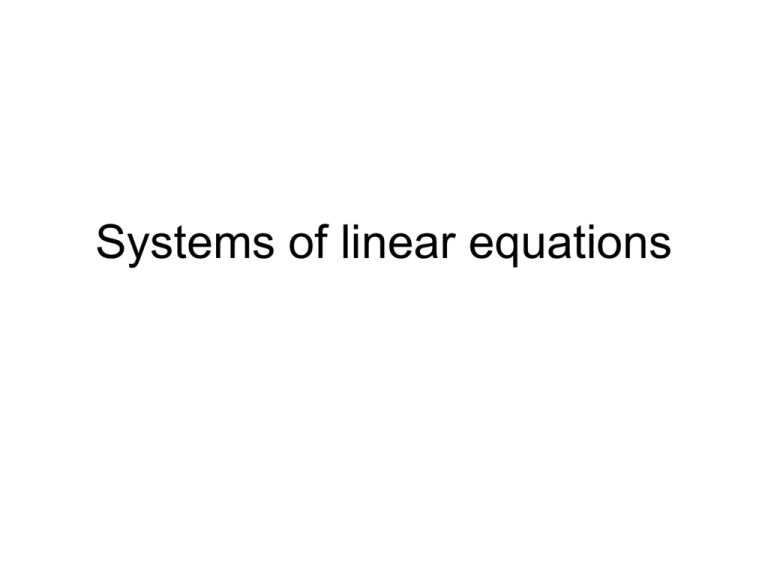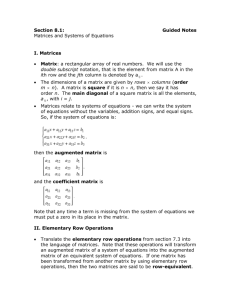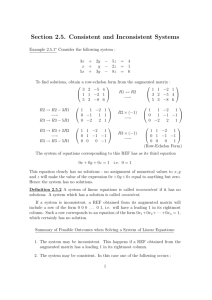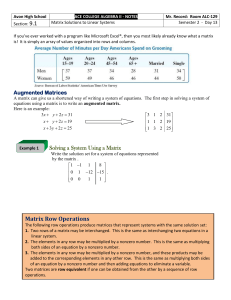Systems of Linear Equations
advertisement

Systems of linear equations Simple system Solve x1 x2 7 2 x1 3x2 6 Solution x1 3, x2 4 Not so simple system Solve x1 3x2 2 x3 2 x5 0 2 x1 6 x2 5 x3 2 x 4 4 x5 3x6 1 5 x3 10 x 4 15 x6 5 2 x1 6 x2 8 x 4 4 x5 18 x6 6 Solution x1 ?, x2 ?, x3 ?, x4 ?, x5 ?, x6 ? Linear equations A line in the xy -plane can be represented algebraically by an equation of the form a1 x a2 y b An equation of this kind is called a linear equation in the variables x and y. Generally, we define a linear equation in the n variables x1 , x2 , , xn to be one that can be expressed in the form a1 x1 a2 x2 an xn b where a1 , a2 , , an , b . The variables in a linear equation are called the unknowns. Examples Linear Not linear x 3y 7 x 3y2 7 x1 2 x2 3x3 x4 7 3 x 2 z xz 4 y 12 x 3 z 1 y sin x 0 x1 x2 xn 1 x1 2 x2 x3 1 Example The solution set of 4 x 2 y 1 is x t, y 2t 12 The solution set of 4 x 2 y 1 is x 12 t 14 , y t The solution set of x1 4 x2 7 x3 5 is x1 5 4s 7t , x2 s, x3 t The solution set of x1 4 x2 7 x3 5 is x1 s, x2 t , x3 75 71 s 74 t Linear systems A finite set of linear equations in the variables x1 , x2 , , xn is called a system of linear equations or a linear system. A sequence of numbers s1 , s2 , system if x1 s1 , x2 s2 , , sn is called a solution of the , xn sn is a solution of every equation in the system. For example, the system 4 x1 x2 3x3 1 3x1 x2 9 x3 4 has the solution x1 1, x2 2, x3 1 since these values satisfy both equations. However, x1 1, x2 8, x3 1 is not a solution since it satisfies only the first equation. Consistency If we multiply the second equation of the system x y 4 2x 2 y 6 by 12 , it is obvious there are no solutions since the equivalent system x y 4 x y 3 has contradictory equations. A system of equations that has no solution is said to be inconsistent; if there is at least one solution of the system, it is said to be consistent. Solution possibilities for two lines Consider the solutions to the general system of two linear equations in the two unknowns x and y: a1 x b1 y c1 a2 x b2 y c2 (a1 , b1 not both zero) (a2 , b2 not both zero) The graphs of these equations are lines; call them l1 and l2 . Then the solutions of the system correspond to the intersections of the lines. A ‘deep’ statement Every system of linear equations has either no solutions, exactly one solution, or infinitely many solutions. Augmented matrices An arbitrary system of m linear equations in n unknowns can be written as a11 x1 a12 x2 a1n xn b1 a21 x1 a22 x2 a2 n xn b2 am1 x1 am 2 x2 amn xn bm Keeping mental track of the 's, the x's and the 's, we can write the system as a rectangular array of numbers: a11 a 21 am1 a12 a22 a1n a2 n am 2 amn b1 b2 bm This is called the augmented matrix for the system. Example The augmented matrix for the system x1 x2 2 x3 9 2 x1 4 x2 3x3 1 3x1 6 x2 5 x3 0 is 1 1 2 9 2 4 3 1 3 6 5 0 Do handout Q1-Q8 Solving a system The main idea here is to replace the given system by a new system that has the same solution set but which is easier to solve. We apply the following three types of operations to eliminate unknowns systematically: 1. Multiply an equation by a non-zero constant. 2. Interchange two equations. 3. Add a multiple of one equation to another. These operations correspond to the following elementary row operations on the augmented matrix: 1. Multiply a row by a non-zero constant. 2. Interchange two rows. 3. Add a multiple of one row to another row. An example An example An example The (unique) solution is x 1, y 2 and z 3. Echelon form In the last example the linear system was solved by reducing the augmented matrix to 1 0 0 1 0 1 0 2 0 0 1 3 We wish to reduce our matrices to those with the following properties: 1. If a row does not consist entirely of zeros, then the first nonzero number in the row is a 1. (This is called a leading 1.) 2. If there are any rows that consist entirely of zeros, then they are grouped together at the bottom of the matrix. 3. In any two successive rows that do not consist entirely of zeros, the leading 1 in the lower rows occurs farther to the right than the leading row in the higher row. 4. Each column with a leading 1 has zeros everywhere else. Echelon form Echelon matrices 1. If a row does not consist entirely of zeros, then the first nonzero number in the row is a 1. (This is called a leading 1.) 2. If there are any rows that consist entirely of zeros, then they are grouped together at the bottom of the matrix. 3. In any two successive rows that do not consist entirely of zeros, the leading 1 in the lower rows occurs farther to the right than the leading row in the higher row. 4. Each column with a leading 1 has zeros everywhere else. A matrix having properties 1, 2 and 3 (but not necessarily 4) is said to be in row-echelon form. A matrix having properties 1, 2, 3 and 4 is said to be in reduced row-echelon form. Reduced versus non-reduced The following matrices are in reduced row-echelon form: 0 1 0 0 4 1 0 0 0 1 0 7 , 0 1 0 , 0 0 0 0 1 1 0 0 1 0 1 2 0 0 0 0 0 0 0 1 0 0 1 3 0 0 , 0 0 0 0 The following matrices are in row-echelon form but not reduced row-echelon form: 1 4 3 7 0 1 6 2 , 0 0 1 5 1 1 0 0 1 0 , 0 0 0 1 1 2 6 0 0 0 1 1 0 0 0 0 0 1 From echelon form to solution (Example 1: unique solution) In the last example the row-reduced matrix was: 1 0 0 1 0 1 0 2 0 0 1 3 Here inspection provides the unique solution: x1 1, x2 2, x3 3 From echelon form to solution (Example 2: infinite solutions) Consider the row-reduced matrix: 1 0 0 0 6 0 0 0 0 1 0 0 0 0 1 0 4 2 3 1 5 2 0 0 Since x1 , x3 and x4 correspond to leading 1's in the augmented matrix, we call them leading variables. The nonleading variables (in this case x2 and x5 ) are called free variables. Solving for the leading variables in terms of the free variables we obtain: x1 2 6 x2 4 x5 , x3 1 3x5 , x4 2 5 x5 Finally, we set the free variables x2 s and x5 t to obtain a parameterisation for the infinite solutions: x1 2 6s 4t , x2 s, x3 1 3t , x4 2 5t , x5 t From echelon form to solution (Example 3: no solutions) Consider the row-reduced matrix 1 0 0 0 0 1 2 0 0 0 0 1 The last equation in the corresponding system of equations is 0 x1 0 x2 0 x3 1 which cannot be satisfied, so there is no solution to the system. Gaussian elimination: an example Gaussian elimination: an example The matrix is now in row-echelon form! Gaussian elimination: an example The matrix is now in reduced row-echelon form! The above procedure for reducing a matrix to reduced row-echelon form is called Gauss-Jordan elimination. If we use only the first five steps, the procedure produces a row-echelon form and is called Gaussian elimination. Not so simple system x1 3x2 2 x3 2 x5 0 2 x1 6 x2 5 x3 2 x 4 4 x5 3x6 1 5 x3 10 x 4 2 x1 6 x2 1 2 0 2 1 0 0 0 1 0 0 0 3 2 0 2 0 0 6 5 2 4 3 1 0 5 10 0 15 5 6 0 8 4 18 6 3 2 0 2 0 0 0 1 2 0 3 1 0 0 0 0 1 13 0 0 0 0 0 0 3 0 4 2 0 0 0 1 2 0 0 0 0 0 0 0 1 13 0 0 0 0 0 0 15 x6 5 8 x 4 4 x5 18 x6 6 Augmented matrix Solution x1 3r 4s 2t Row-echelon form x2 r x3 2s x4 s x5 t x6 13 Reduced row-echelon form Back-substitution x1 3x2 2 x3 2 x5 0 2 x1 6 x2 5 x3 2 x 4 4 x5 3x6 1 5 x3 10 x 4 2 x1 6 x2 1 0 0 0 3 2 0 2 0 0 0 1 2 0 3 1 0 0 0 0 1 13 0 0 0 0 0 0 15 x6 5 8 x 4 4 x5 18 x6 6 Row-echelon form Substituting x6 13 Solving for the lead variables: into second equation: x1 3 x2 2 x3 2 x5 x1 3x2 2 x3 2 x5 x3 1 2 x4 3 x6 x3 2 x4 x6 x6 13 1 3 Substituting x3 2 x4 into first equation: x1 3 x2 4 x4 2 x5 x3 2 x4 x6 13 This is the same solution!! x1 3r 4s 2t , x2 r , x3 2s, x4 s, x5 t , x6 13 Homogeneous linear systems A linear system is said to be homogeneous if it has the following form : a11 x1 a12 x2 a1n xn 0 a21 x1 a22 x2 a2 n xn 0 am1 x1 am 2 x2 amn xn 0 Every homogeneous linear system is consistent, since all such systems have x1 0, x2 0, , xn 0 as a solution. This solution is called the trivial solution; if there are other solutions, they are called nontrivial solutions. So a homogenous system either has only the trivial solution, or infinitely many solutions in addition to the trivial solution. All such systems are consistent. Homogeneous linear systems Consider the solutions to the homogeneous system of two linear equations in the two unknowns x and y: a1 x b1 y 0 (a1 , b1 not both zero) a2 x b2 y 0 (a2 , b2 not both zero) Do Handout Q1-Q26 Theorem: A homogeneous system of linear equations with more unknowns than equations has infinitely many solutions. Note: A consistent nonhomogeneous system with more unknowns than equations also has infinitely many solutions.





